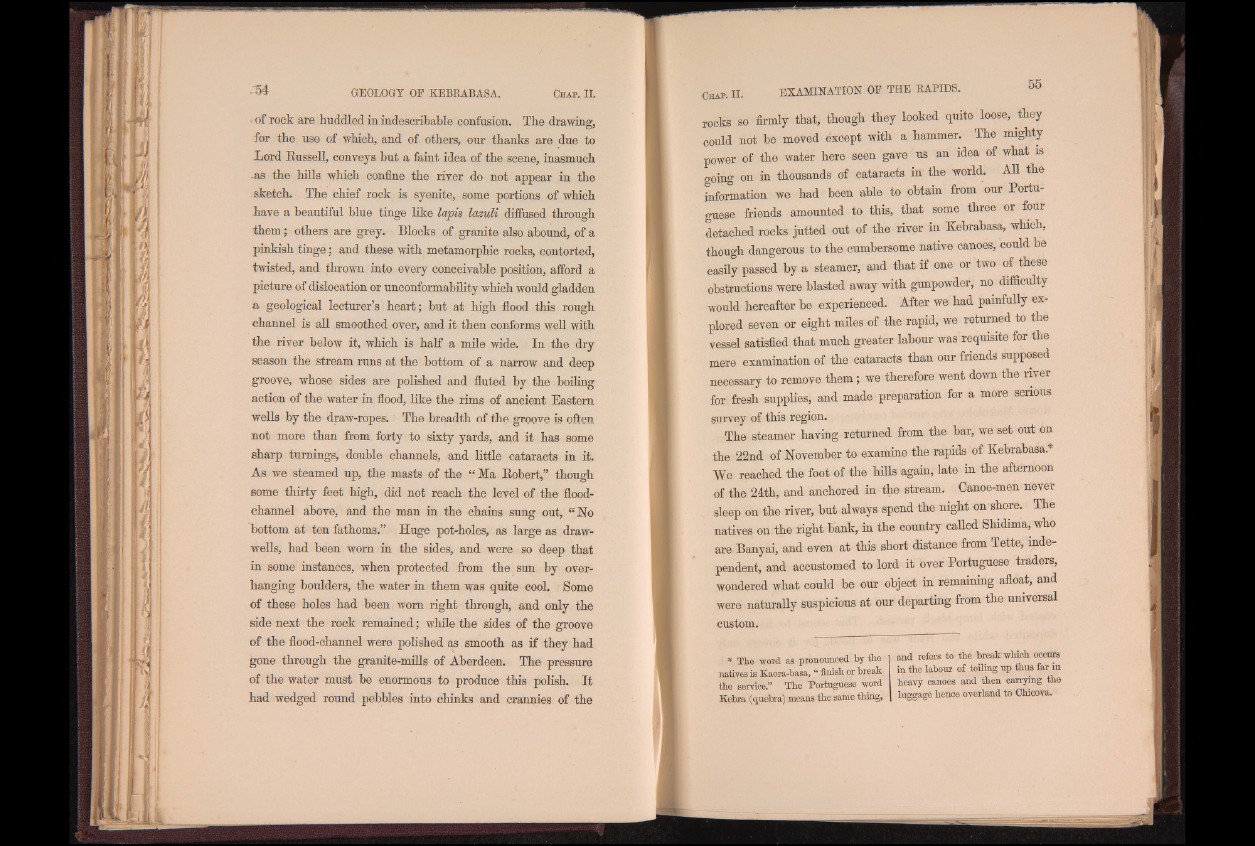
of rock are huddled in indescribable confusion. The drawing,
for the use of which, and of others, our thanks are due to
Lord Russell, conveys but a faint idea of the scene, inasmuch
as the hills which confine the river do not appear in the
sketch. The chief rock is syenite, some portions of which
have a beautiful blue tinge like lapis lazuli diffused through
them; others are grey. Blocks of granite also abound, of a
pinkish tinge; and these with metamorphic rocks, contorted,
twisted, and thrown into every conceivable position, afford a
picture of dislocation or unconformability which would gladden
a geological lecturer’s heart; but at high flood this rough
channel is all smoothed over, and it then conforms well with
the river below it, which is half a mile wide. In the dry
season the stream runs at the bottom of a narrow and deep
groove, whose sides are polished and fluted by the boiling
action of the water in flood, like the rims of ancient Eastern
wells by the draw-ropes. The breadth of the groove is often
not more than from forty to sixty yards, and it has some
sharp turnings, double channels, and little cataracts in it.
As we steamed up, the masts of the “ Ma Robert,” though
some thirty feet high, did not reach the level of the flood-
channel above, and the man in the chains sung out, “ No
bottom at ten fathoms.” Huge pot-holes, as large as draw-
wells, had been worn in the sides, and were so deep that
in some instances, when protected from the sun by overhanging
boulders, the water in them was quite cool. Some
of these holes had been worn right through, and only the
side next the rock remained; while the sides of the groove
of the flood-channel were polished as smooth as if they had
gone through the granite-mills of Aberdeen. The pressure
of the water must be enormous to produce this polish. It
had wedged round pebbles into chinks and crannies of the
rocks so firmly that, though they looked quite loose, they
could not be moved except with a hammer. The mighty
power of the water here seen gave us an idea of what is
going on in thousands of cataracts in the world. All the
information we had been able to obtain from our Portuguese
friends amounted to this, that some three or four
detached rocks jutted out of the river in Kebrabasa, which,
though dangerous to the cumbersome native canoes, could be
easily passed by a steamer, and that if one or two of these
obstructions were blasted away with gunpowder, no difficulty
would hereafter be experienced. After we had painfully explored
seven or eight miles of the rapid, we returned to the
vessel satisfied that much greater labour was requisite for the
mere examination of the cataracts than our friends supposed
necessary to remove them; we therefore went down the river
for fresh supplies, and made preparation for a more serious
survey of this region.
The steamer having returned from the bar, we set out on
the 22nd of November to examine the rapids of Kebrabasa.*
We reached the foot of the hills again, late in the afternoon
of the 24th, and anchored in the stream. Canoe-men never
sleep on the river, but always spend the night on shore. The
natives on the right bank, in the country called Shidima, who
are Banyai, and even at this short distance from Tette, independent,
and accustomed to lord it over Portuguese traders,
wondered what could be our object in remaining afloat, and
were naturally suspicious at our departing from the universal
custom.
* The word as pronounced by the
natives is Kaora-basa, “ finish or break
the service.” The Portuguese word
Kebra (quebra) means the same thing,
and refers to the break which occurs
in the labour of toiling up thus far in
heavy canoes and then carrying the
luggage hence overland to Chicova.